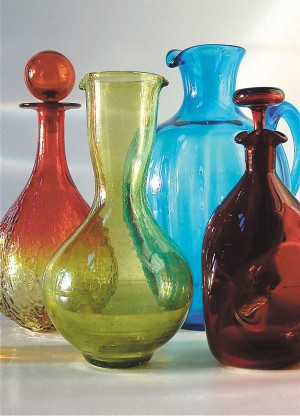As we crossed over into the new millennium a large percentage of the American buying public began to snub collectible glassware. Values plummeted, dealers wouldn’t touch it and, with the exception of a few hardcore collectors, the collectible glassware market in the US slowed to a crawl!.
Then, very gradually, that began to change.
As the interest in MCM decor increased, so did the interest in glassware from the mid-20th Century. The streamline furnishings of the MCM era set the perfect backdrop for these brightly colored vases, bottles and jars which were a welcome change from the heavy stoneware/pottery pieces so popular in the early part of 2000.
Collectible glassware has made a comeback and is once again front and center at malls and vintage markets everywhere, and values have sky-rocketed. So, what kind of glass is in demand? Here are a few two of my favorites which you will want to watch for as you hit the estate sales and auctions this fall.
Crackle glass, manufactured from the 1930 till the mid-1970s, leads the way as the top selling form of art glass. These highly collectible pieces of glass are made by submerging hot glass into cold water. When fine lines appear the glass is reheated and hand-blown.
Pilgrim Glass Company, Cambridge Glass, Boston & Sandwich Glass Company and H.C. Fry are all notable manufacturers of crackle, but if you ask most collectors their “pièce de résistance,” they will tell you, Blenko!
Blenko Glass of Milton, West Virginia was one of the most prolific of the crackle glass factories, making an abundance of their product available today. Pieces range from the fairly common 384 water bottle to more rare examples like the footed vases and decanters designed by John Nickerson (1953-1963) and Wayne Husted (1970-1974).
Swung glass is glass that has been pressed into a mold which, after a slight cooling time, is literally “swung” by a glassblower. The swinging motion causes the glass to stretch after which the mouth of the piece is formed into the desired shape.
This American-made glass was produced mainly by the L.E. Smith and Viking glass companies from the early part of the 1960s through the 1980s. Identification of the factory of origin can be tricky as many of these pieces were marked with a paper tag, many of which have not survived the passage of time.
Sometimes color can be the clue to the factory of origin. Viking Swung glass is pink, purple or white, while L.E. Smith pieces are usually found in olive green, turquoise, shades or orange and some black. Most Viking Swung glass vases are supported by a pedestal base, unlike L E Smith cases that will usually have a flat base
Public awareness of the increased popularity of collectible MCM glass is on the rise, making a bargain hard to find. But, if you keep a close eye out when you are browsing the resale shops and flea markets, there are still bargains to be had.
Until next time . . . Linda
Linda Kennett is a professional liquidation consultant specializing in down-sizing for seniors and the liquidation of estates.



